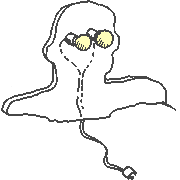|
Do you mean you're trying to fold webbing over and stitch it down to increase the thickness? I think the point of that pattern is to take regular fabric and make it into a string by folding and stitching down. And the point of that is to make your drawstring pretty. I wouldn't imagine that webbing would fold like that. I also can't imagine that it would look good as the drawstring of a bag. Are you committed to using it? Either using fabric, like in the pattern, or going to your local fabric store and getting 50c worth of cord, would be easier and look better.
|
|
|
|

|
| # ? Apr 25, 2024 17:02 |
|
Pondex posted:Is there any way to make a double-drawstring bag like this, without having the cords crossing each other inside the channel? Sew two channels?
|
|
|
|
armorer posted:Sew two channels? Yeah this is what's confusing me about the OP's question. The pattern they linked literally has two channels. The only place the two cords meet is at the knots at the end.
|
|
|
|
I'm using the webbing for the drawstrings. But there's two drawstrings running through each channel from opposite sides. And as far as I can figure out, they're always going to cross inside the channel and wrap around each other. Which I don't really care for. Like this:  I may just need some thinner straps. Or a wider channel
|
|
|
|
If you're committed to using wide webbing having a single loop works at the cost of being slightly more awkward to close the bag. It also won't be as secure when closed.
|
|
|
|
ephphatha posted:If you're committed to using wide webbing having a single loop works at the cost of being slightly more awkward to close the bag. It also won't be as secure when closed. The webbing doubles as shoulder-straps so I need two unfortunately. Like this one: 
|
|
|
|
Ah right, I see. Yeah one option would be two separate channels, one above the other.Pondex posted:The webbing doubles as shoulder-straps so I need two unfortunately. ... but the option of separate channels will look weird if this is your goal. I don't think I've ever seen one of those beach bags with actual webbing/strap material. Usually they just use thick-ish soft cord for the shoulder straps (like in the picture), and work on the assumption that you won't be carrying anything heavy in them. If you really want webbing straps, maybe try to make a design where the straps and bag closure aren't a single thing? Like just sew the straps into the seams and get some cord for the closure? It'd also be easier to put in strap adjusters.
|
|
|
|
Lead out in cuffs posted:Ah right, I see. Yeah one option would be two separate channels, one above the other. Yeah I meant two stacked channels so the webbing wouldn't ever be in the same path. I've made a number of bags like this myself, but never used wide webbing so I haven't run into this issue. With thin ribbon or cord it's a non-issue.
|
|
|
|
I'm making a throw rug out of these cotton braids and I'm getting a knocking sound from my machine no matter what I do. Any tips? I've tried adjusting the thread-tension, presser-foot tension, changed the needle, changed the type of needle. So I'm stumped. It's a Singer 4411 so it should be strong enough.
|
|
|
|
Try lowering the feed dogs and see if that makes a difference, it could be slightly snarling up each time they move?
|
|
|
|
learnincurve posted:Try lowering the feed dogs and see if that makes a difference, it could be slightly snarling up each time they move? As far as I can tell they're not adjustable on this machine. You can drop them completely for freehand sewing but that's it.
|
|
|
|
Does it knock when you crank by hand? Does it knock when you use something like parchment paper with it? Does it knock when you sew something thinner? Does it knock when you try a different size or composition of thread?
|
|
|
|
Pondex posted:As far as I can tell they're not adjustable on this machine. You can drop them completely for freehand sewing but that's it. Thatís the kitty, drop them completely and try freehand to eliminate one moving part 
|
|
|
|
effika posted:Does it knock when you crank by hand? 1: Yes, if I move it fast. 2: If you mean paper between the fabric and feed dogs, then yes. 3: No. 4: I haven't tried another thread, but it's brand new gŁtermann polyester-thread.
|
|
|
|
learnincurve posted:Thatís the kitty, drop them completely and try freehand to eliminate one moving part It doesn't make the sound sewing in place, but moving the fabric causes knocking again.
|
|
|
|
Pondex posted:It doesn't make the sound sewing in place, but moving the fabric causes knocking again. Ok good then itís not terminal or expensive. On my singer machine when Iím quilting it absolutely hates the bobbin being horizontal - it has auto tension and does this thing where it cuts out when you go too fast and it detects the thread is about to snap - having it upright tends to cut out this issue. I would wonder if your knocking is to do with same issue.
|
|
|
|
I have one of those Singers and experience the same knocking with heavier fabric and thread. I found two things: the first was the needle impacting the bobbin case. The more significant noise, though, was indeed related to thread tension, and bumping it up to 6 reduced the knocking. It does still knock a bit, but not quite so much at slower speeds. I'm pretty sure that I'm missing something here and haven't found a definitive cause. I have a hunch that it's actually the little timing adjustment thing inside the head (?) of the machine (above the needle) that's the real source of the noise. (Not sure, haven't needed to pull the machine out recently and really dig into it.)
|
|
|
|
Just did a test with 12 layers of a light cotton canvas. No issues or knocking at all. My machine must hate braids.
|
|
|
|
My totally pulled out my arse theory: the fabric is really stiff and angled in places in the braid, such that it's bending the needle just enough to make it bump into the bobbin case.
|
|
|
|
Lead out in cuffs posted:My totally pulled out my arse theory: the fabric is really stiff and angled in places in the braid, such that it's bending the needle just enough to make it bump into the bobbin case. Yeah, it seems like the needle is deflecting, since the machine can sew a lot of straight layers easily. Maybe a beefy microtex-needle can solve it.
|
|
|
|
If I wanted to make a cover for my ikea POANG where would I even start with that? Like I don't think there are patterns available for purchase so can I measure the cushions and just make big rectangles? What kind of fabric do I use for furniture?
|
|
|
|
Same principle as measuring for and assembling a cardboard box, but you got to add on an inch all round to give yourself seam room and some give. Iím a rank amateur and I always do these things super slow. Measure cushion area, add on inch, cut out, measure back area, add inch, cut out and so on till I got all the bits ready to assemble. Fabric would depend on your machine, singer heavy duty would go through very heavy denims but a more average machine Iíd go for a heavy cotton.
|
|
|
|
Killingyouguy! posted:If I wanted to make a cover for my ikea POANG where would I even start with that? Like I don't think there are patterns available for purchase so can I measure the cushions and just make big rectangles? What kind of fabric do I use for furniture? First measure them and make big rectangles. REMEMBER TO ADD SEAM ALLOWANCES ON ALL SIDES. Then buy some cheap fabric from Joanne's/Michael's bargain bin, baste together (loose stitches either by hand or by machine) a cover and see if it fits. You get upholstery fabric either in the "home decor" section of your fabric store or online. I've been happy with everything I got from fabric.com (sorry to see they're an Amazon company now  ) and they'll send you swatches. ) and they'll send you swatches.
|
|
|
|
Hello sewing thread, I have a question that I'm pretty sure I know the answer to but would rather have more knowledgeable input on. I want to sew some masks, it's been ages since I've used a sewing machine. I was passable at it like... 20+ years ago. I have two sewing machines available to use. One is a Singer 2932, which I'm pretty sure is a flimsy plastic thing that has never worked particularly well since I bought it. The internet seems to agree with me. I also inherited my grandmother's Singer 457, which weighs an absurd amount and was made in Great Britain, not China. I probably want to use the 457, right? Assuming that it actually works, I've not plugged it in to try it since it arrived.
|
|
|
|
|
Yes absolutely, under the skin and dials itís near enough identical to the singer heavy duty. The 2932 is part of a series thatís dogshit at multiple layers.
|
|
|
|
Arsenic Lupin posted:buy some cheap fabric from Joanne's/Michael's bargain bin Thrift store sheets are my go-to for this sort of thing.
|
|
|
|
Hi sewing goons! I do wet plate collodion photography (old timey 1850s process), which requires plates to be sensitised and developed in the field, meaning I have to bring my darkroom with me. I've got a DIY darkbox thing I use when shooting out of the back of my car which works great, but also wanted something a bit more portable so I'm not tied to the vehicle for every shoot. My plan was to get one of those shower/toilet/changing tents and replace the existing nylon fabric with some lightweight blackout fabric:  link to product page (Ilford actually just announced a similar sort of product to what I want to make, but it looks like it's meant for indoor use and takes a while to setup, plus it'll probably be AUD$500+ by the time it gets to Australia). My question is: how difficult of a project does this look like for a total beginner? There's a local sewing place that offers classes (and extremely reasonable rates on using their machines/big sewing room), and I'd love to pick up a new skill, but if it looked like it'd require a lot of expertise I'd probably be better to farm it out to a local sewing place. I'd be going for as simple as possible - wouldn't bother with any of the pockets, vents, or windows.
|
|
|
|
That big, curved zipper will be a bitch.
|
|
|
|
Why not make a bigger ďovercoatĒ out of the blackout fabric that has 2 panels, one from each side, over the entrance? Like a giant outer skin? That would be way easier and have easier seams, with no need for a fastener as long as you sew down both flaps low enough.
|
|
|
|
I agree that your idea would be an advanced project. I like hutla's idea for something easier! I was also initially thinking of just sewing your blackout panels directly on to the existing nylon panels. That could work and be easier as well. Then hand-sew some buttons for a flap closure. Either way, I think you'll definitely want to try a few 'intro' DIY projects to get used to sewing first, so maybe a couple classes would be good!
|
|
|
|
Thanks for the advice, everybody!HelloIAmYourHeart posted:That big, curved zipper will be a bitch. Yeah, I should have mentioned I was going to skip that and just do a flap (in addition to the hassle sewing, zippers can be tricky to lightproof anyways) Hutla posted:Why not make a bigger ďovercoatĒ out of the blackout fabric that has 2 panels, one from each side, over the entrance? Like a giant outer skin? That would be way easier and have easier seams, with no need for a fastener as long as you sew down both flaps low enough. Hmm, that's not a bad idea. It would have to go completely over the skeleton thing though; the material on those tents is not actually 100% opaque. On the other hand it would add a fair bit of complexity to the setup, which might make the purpose-built Ilford one worth it. cloudy posted:I agree that your idea would be an advanced project. I like hutla's idea for something easier! I was also initially thinking of just sewing your blackout panels directly on to the existing nylon panels. That could work and be easier as well. Then hand-sew some buttons for a flap closure. I like the idea (it suits my laziness pretty well) but I have a feeling it wouldn't fold up very nicely anymore if I did that. I may try a smaller, related project, which is making a copy of this folding fabric storage box, which can be turned into a darkbox with a bit of modification. (The product has been discontinued and I can't find anything of similar size/portability).
|
|
|
|
Hi again sewing thread, I have another thing that needs repairing. It's this wild bootleg betty boop sequined top. It's a pretty special and rare piece. Unfortunately it has a pretty big tear in it. As far as I can tell they are all still attached, and only the fabric between the sequins is what tore.  Luckily the lining doesn't have a tear in it. Both the lining and the rest of the body are made out of the same gauzy silk. It's very delicate.  I was considering finding some non fusible interfacing, putting it in between the body and lining and then going over the adjacent rows of sequins with some inconspicuous reinforcing backstitching. Maybe I'll try to put a blanket stitch on the torn edge of the fabric to keep it from unraveling. Any suggestions?
|
|
|
|
kreeningsons posted:Hi again sewing thread, I have another thing that needs repairing. It's this wild bootleg betty boop sequined top. It's a pretty special and rare piece. Given that it's torn along the lines of the beading, I would tend to take it in four steps. 1. Attach very lightweight interfacing to the back, concealing the stitching of the edges of the patch in between the rows of sequins. 2. Run a black thread through the loose line of sequins at the left, then anchor it down to the fabric; this will prevent the tear from continuing to run. 3. Whip-stitch the black line of sequins through the fabric and into the interfacing, slipping each stitch between two sequins. 4. Lift up the beaded black line to where it should go , move it a little above the bottom edge of the sequined layer, and again whipstitch down. e: I would recommend knit interfacing from Fashion Sewing Supply. The great thing about knit interfacing, even when used on woven fabrics, is that it doesn't stop the fabric it's attached to from moving a little. This helps avoid the problem of delicate fabric tearing at the places you attached the patch. Arsenic Lupin fucked around with this message at 18:01 on Sep 20, 2021 |
|
|
|
I haven't made an actual garment for real life wearing in a very long time, only theatrical alterations. Those are generally of "this will make this $5 thrift store item hold up for 2 weeks" quality and a lot of hand sewing. I thought I'd try making https://www.sewaholicpatterns.com/belcarra-blouse-pdf-sewing-pattern/ since it's pretty simple, but I'm getting stuck on choosing a fabric that will drape nicely but not be too difficult to sew on. Any suggestions?
|
|
|
|
Arsenic Lupin posted:Given that it's torn along the lines of the beading, I would tend to take it in four steps. I'd also think about using invisible thread for this particular repair.
|
|
|
|
Hutla posted:
Oh hey, I've made this one! It's become one of my favourite summer T-shirts. I used a lightweight viscose fabric which does drape nicely but which was also quite slippery at times. For another pattern I recently used a cotton voile/viscose blend and I think that would also work well for this one. It was relatively easy to work with while still being quite drapey.
|
|
|
|
Hutla posted:I haven't made an actual garment for real life wearing in a very long time, only theatrical alterations. Those are generally of "this will make this $5 thrift store item hold up for 2 weeks" quality and a lot of hand sewing. Iím a huge fan of cotton lawn for pretty much everything clothing, the way it drapes is fantastic and itís a dream to cut and sew. The eBay search is cotton lawn/Liberty cotton lawn/tana cotton lawn.
|
|
|
|
Arsenic Lupin posted:Given that it's torn along the lines of the beading, I would tend to take it in four steps. Thank you for the detailed instructions! I will get my hands on some materials and give it a shot
|
|
|
|
Should I get a used Husqvarna Designer 1 if I don't have a great need to do embroidery? It's a good price and apparently sews great. I've never owned a computerized machine though.
|
|
|
|

|
| # ? Apr 25, 2024 17:02 |
|
I mean, I have no experience with computerized machines either, but from reviews it looks like it has some neat features - foot pressure at the press of a button, needle down, fancy quilting stitches, button holing. It's also a really good brand, and I suspect you'd start finding uses for the embroidery. (Custom patches? Faces of plushies?) So if the price is really good, you have the disposable income, and you are doing enough sewing that you feel it's justified, then sure, get it.
|
|
|



























